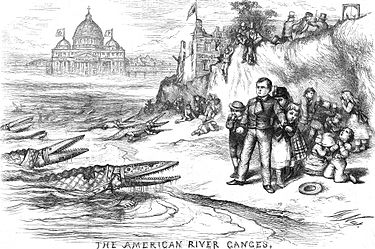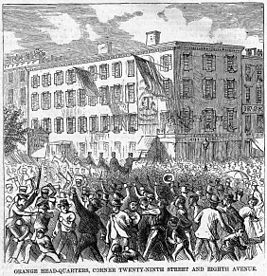- Orange Riots
-
 The Orange riot of 1871 as depicted in Frank Leslie's Illustrated Newspaper. The view is at 25th Street looking south down Eighth Avenue
The Orange riot of 1871 as depicted in Frank Leslie's Illustrated Newspaper. The view is at 25th Street looking south down Eighth Avenue
 An 1871 cartoon by Thomas Nast, protesting at the political power held by Irish Catholics in New York City; the crocodiles are dressed as Catholic bishops.
An 1871 cartoon by Thomas Nast, protesting at the political power held by Irish Catholics in New York City; the crocodiles are dressed as Catholic bishops.
The Orange riots took place in Manhattan, New York City in 1870 and 1871, and involved violent conflict between Irish Protestants, called "Orangemen", and Irish Catholics, along with the New York City Police Department and the New York State National Guard.
Contents
Background
On July 12, 1870 a parade was held in Manhattan by Irish Protestants celebrating the victory at the Battle of the Boyne of William III, the King of England and Prince of Orange, over James II. The parade route was up Eighth Avenue to Elm Park [1] at 92nd Street,[2] and as they went the participants taunted Irish Catholic residents of Hell's Kitchen and others, many of whom followed the parade and returned the harassment. At the park, the crowd of 200 hecklers was joined by a group of 300 Irish laborers working in the neighborhood, and together they attacked the Protestants. Although the police intervened to quell the fighting, 8 people died as a result of the riot.[2][3]
The following year, the Loyal Order of Orange requested police permission to march again, but, fearing another violent incident, the parade was banned by the city's police commissioner, James J. Kelso, with the support of Boss William M. Tweed, the head of Tammany Hall, the Democratic Party political machine which controlled the city and the state. Catholic Archbishop John McCloskey applauded the decision, but Protestants objected, as did newspaper editorials in the Herald and Times, a petition signed by Wall Street businessmen, and a cartoon by Thomas Nast in Harper's. Not only was the ban felt to be giving in to the bad behavior of a Catholic mob, but fears were voiced about the growing political power of Irish Catholics, the increasing visibility of leftish Irish nationalism in the city, and the possibility of a radical political action such as occurred in Paris with the Commune.[2]
The pressure generated by these concerns among the city's elite, on top of pressure from good-government reformers against Tweed's regime in general, caused Tammany to reverse course and allow the march;[2] Tammany needed to show that it could control the immigrant Irish population which formed a major part of its electoral power.[3] Governor John T. Hoffman, a Tammany man, rescinded the police commissioner's ban, and ordered that the paraders be protected by the city police and the state militia,[3] including cavalry.[2]
1871 riot
On July 12, the parade proceeded with protection from 1500 policemen and five regiments of the National Guard, about five thousand men.[2] It was to begin at the Orangemen's headquarters at Lamartine Hall, located at Eighth Avenue and 29th Street;[4] by 1:30pm the streets from 21st to 33rd were full of people, mostly Catholic, and mostly laborers, and both side of the avenue were jammed. The police and militia arrived, to the disapproval of the crowd, and the small contingent of Orangemen began their parade down the avenue at 2pm, surrounded by regimental units.[2]
Almost immediately the crowd began to pelt the paraders with stones, bricks, bottles and shoes, and militiamen responded with musket fire, which brought pistol fire from some in the crowd. The police managed to get the parade moving again by charging the crowd and liberally using their clubs. The parade progressed another block, but came under fire from thrown missiles again, once again provoking militia shots. The crush of the crowds preventing more forward motion, police used their clubs and the militia their bayonets, but rocks and crockery pelted down on them from the rooftops along the avenue. Finally, troops starting firing volleys into the crowd, without being ordered to do so, and the police followed up with mounted charges.[2]
The parade managed to get to 23rd Street, where it turned left and proceeded to Fifth Avenue, where the crowds were supportive of the Orangemen.[2] This changed again when the parade continued south down Fifth and reached the entertainment district below 14 Street, where the crowds were once again hostile. The parade then continued across town to Cooper Union, where the paraders dispersed.[2]
The riot had caused the deaths of over 60 civilians – mostly Irish laborers – and three Guardsmen. Over 150 people were wounded, including 22 militiamen, 20-some policeman injured by thrown missiles and 4 who were shot, but not fatally. About 100 people were arrested.[2]
The following day, on July 13, 20,000 mourners paid their respects to the dead outside the morgue at Bellevue Hospital, and funeral processions made their way to Calvary Cemetery in Queens by way of ferries. Governor Hoffman was hanged in effigy by Irish Catholics in Brooklyn, and the events began to be referred to as the "Slaughter on Eighth Avenue."[2]
Effects
Despite their attempt to protect their political power by allowing the parade to go forward, Tammany Hall did not benefit from the outcome, instead coming under increased criticism from newspapers and the city's elite. Tweed would fall shortly afterwards.
One of the reasons many in the upper and middle classes had grudingly acquiesced in Tammany's hold on power was its presumed ability to maintain political stability. That saving grace was gone: Tweed could not keep the Irish in line. The time had come, said Congregationalist minister Merrill Richardson from the pulpit of his fashionable Madison Avenue church, to take back New York City, for if "the higher classes will not govern, the lower classes will."[5]
Banker Henry Smith told the New York Tribune that "such a lesson was needed every few years. Had one thousand of the rioters been killed, it would have had the effect of completely cowing the remainder."[5]
See also
References
- Notes
- Bibliography
- Gilmore, Russell S. "Orange riots" in Jackson, Kenneth T., ed (1995). The Encyclopedia of New York City. New Haven: Yale University Press. ISBN 0300055366.
- Burrows, Edwin G. & Wallace, Mike (1999). Gotham: A History of New York City to 1898. New York: Oxford University Press. ISBN 0195116348.
Categories:- Riots and civil unrest in New York City
- 1870 riots
- 1871 riots
- 1870 in New York
- 1871 in New York
Wikimedia Foundation. 2010.

